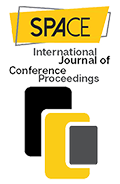The Reading of Art in Virtual Reality in the Postmodern Period
DOI:
https://doi.org/10.51596/sijocp.v3i1.50Keywords:
Postmodernism, art, virtual reality, interaction, pluralityAbstract
Postmodernism, a mid-20th-century cultural movement reacting against modernism, challenges grand narratives and absolute truth, emphasising fragmentation. Virtual Reality (VR), simulating real or alternative experiences, has become an accessible artistic medium. Postmodern art in VR is self-referential and interactive, exploring reality-simulation dynamics.
Artists like Gibson/Martelli's "The History of the Future" transport users to a dystopian future, emphasising activism and choice. Jacolby Satterwhite employs VR for performance, blurring virtual and real through digital sculptures and live presentations.
VR in postmodern art prompts questions about reality and viewer-artwork relationships. As users immerse in virtual environments, the line between reality and simulation blurs, challenging traditional ideas of authorship and interpretation. Multiple perspectives emerge, aligning with a postmodern emphasis on plurality.
The abstract concludes by asserting VR's role as a platform for postmodern exploration, enabling new forms of expression and interaction, and pushing artistic boundaries.
References
Alexander, B. and Tomanek, A. (2017). The influence of postmodernism on the evolution of art in the 21st century. European Scientific E-Journal. https://doi.org/10.47451/art2020-12-005
Alexander, B. and Tomanek, A. (2017). The influence of postmodernism on the evolution of art in the 21st century. European Scientific E-Journal. https://doi.org/10.47451/art2020-12-005
Armitage, J. (2022). Rethinking haute couture: Julien fournié in the virtual worlds of the metaverse. French Cultural Studies, 34(2), 129-146. https://doi.org/10.1177/09571558221109708
Artut, S. 2014. Technology-Human Cooperation. Ayrıntı Publications. Istanbul
Ballı Ö. 2021. The Use of Virtual Reality Technology in the Artistic Production Process in the Context of Digitalized Art. İdil, 77 (2021 Ocak): s. 63–78. https://doi.org/10.7816/idil-10-77-06
Başar Ç.T. 2020. Virtual Reality in a Contemporary Art Environment.17th International Symposium Communication in the Millennium. ISBN: 978-605-83703-9-5
Chistyakova, O. (2018). Postmodern philosophy and contemporary art. https://doi.org/10.2991/icadce-18.2018.26
Choi, Y., Jung, S., & Kim, J. (2020). Immersive 3d body painting system. https://doi.org/10.1145/3415264.3425467
Efrat, L. (2020). Relational perspectives: strategies for expanding beyond the here and now in mobile augmented reality (AR) art. Leonardo, 53(4), 374-379. https://doi.org/10.1162/leon_a_01922
Ganczarek, J., Pietras, K., Stolińska, A., & Szubielska, M. (2022). Titles and semantic violations affect eye movements when viewing contemporary paintings. Frontiers in Human Neuroscience, 16. https://doi.org/10.3389/fnhum.2022.808330
Geron, T. 2011. Viewdle’s SocialCamera App Tags And Learns Your Friends’ Faces. Forbes [online], https://www.forbes.com/sites/tomiogeron/2011/04/27/viewdles-socialcamera-app-tags-and-learns-your-friends-faces/?sh=7f7507537057. (Retrieved: 13.11.2020).
Hacmun, I., Regev, D., & Salomon, R. (2018). The principles of art therapy in virtual reality. Frontiers in Psychology, 9. https://doi.org/10.3389/fpsyg.2018.02082
Havrylenko, Y., Hrytsun, Y., Kondratenko, I., & Sukhova, L. (2022). Development of Ukrainian choral art in conditions of postmodernism. Postmodern Openings, 13(2), 345-357. https://doi.org/10.18662/po/13.2/458
Lichty, P. (2000). The cybernetics of performance and new media art. Leonardo, 33(5), 351-354. https://doi.org/10.1162/002409400552810
Lichty, P. (2014). The aesthetics of liminality: augmentation as an art form. Leonardo, 47(4), 325-336. https://doi.org/10.1162/leon_a_00837.
Liu, B. (2019). Research of digital media art based on virtual reality on animation design.. https://doi.org/10.2991/emehss-19.2019.68
Lyu, Q., Watanabe, K., Umemura, H., & Murai, A. (2023). Design-thinking skill enhancement in virtual reality: a literature study. Frontiers in Virtual Reality, 4. https://doi.org/10.3389/frvir.2023.1137293
Меньшиков, Л. (2019). Ironic strategies of postmodern art games. Journal of Siberian Federal University Humanities & Social Sciences, 1174-1190. https://doi.org/10.17516/1997-1370-0199.
Muth, C. and Carbon, C. (2016). Seins: semantic instability in art. Art & Perception, 4(1-2), 145-184. https://doi.org/10.1163/22134913-00002049
Rizzo, A. and Koenig, S. (2017). Is clinical virtual reality ready for primetime?. Neuropsychology, 31(8), 877-899. https://doi.org/10.1037/neu0000405
Rothe, S., Buschek, D., & Hußmann, H. (2019). Guidance in cinematic virtual reality-taxonomy, research status, and challenges. Multimodal Technologies and Interaction, 3(1), 19. https://doi.org/10.3390/mti3010019.
Serrano, A., Sitzmann, V., Ruiz-Borau, J., Wetzstein, G., Gutiérrez, D., & Masiá, B. (2017). Movie editing and cognitive event segmentation in virtual reality video. Acm Transactions on Graphics, 36(4), 1-12. https://doi.org/10.1145/3072959.3073668
Soccini, A. (2016). Virtual and augmented reality in the art of Lucio Fontana. https://doi.org/10.14236/ewic/eva2016.30
Tuğal, S.A. 2018. Digital Art In the Process of Formation. Hayalperest Bookstore, Istanbul.
Tong, L., Lindeman, R., & Regenbrecht, H. (2021). Viewer’s role and viewer interaction in cinematic virtual reality. Computers, 10(5), 66. https://doi.org/10.3390/computers10050066
Oriekhova, L., ANDRIICHUK, P., Shnurenko, T., Horobets, V., Синельникова, В., & SINELNIKOV, I. (2022). The research of computer simulation of textual dimension in the context of the musical discourse. Postmodern Openings, 13(3), 310-322. https://doi.org/10.18662/po/13.3/491.
Wang, P., Wu, P., Wang, D., Chi, H., & Wang, X. (2018). A critical review of the use of virtual reality in construction engineering education and training. International Journal of Environmental Research and Public Health, 15(6), 1204. https://doi.org/10.3390/ijerph15061204.
Wongso, M. and Istiono, W. (2023). Learn Muay Thai basic movement in virtual reality and the sattolo shuffle algorithm. International Journal of Science Technology & Management, 4(2), 341-349. https://doi.org/10.46729/ijstm.v4i2.759.
Wu, S. (2014). Negotiation of narratives in a postmodern picture book. Theory and Practice in Language Studies, 4(4). https://doi.org/10.4304/tpls.4.4.806-810.
Xu, X. and Zhu, J. (2021). Artistic color virtual reality implementation based on similarity image restoration. Complexity, 2021, 1-12. https://doi.org/10.1155/2021/7572654.
Yun-xuan, W. (2022). Application of artificial intelligence within virtual reality for the production of digital media art. Computational Intelligence and Neuroscience, 2022, 1-10. https://doi.org/10.1155/2022/3781750.
Zhilyaeva, A. 2018. Volumism: future of art | TEDxBologna [online], https://www.youtube.com/watch?v=Y0CQfsb5Wsc&feature=youtu.be (Retrieved: 12.11.2020).
Zohdi, E. and Oroskhan, M. (2015). Kiarostami’s through the olive tree: a postmodern analysis. Theory and Practice in Language Studies, 5(10), 2144. https://doi.org/10.17507/tpls.0510.23
Zuhro, A., Sunarya, I., & Nugraheni, W. (2020). Batik nitik’s existence in the postmodern era.. https://doi.org/10.2991/assehr.k.200703.001
Zhang, X. (2022). Virtual digital communication feature fusion based on virtual augmented reality. Security and Communication Networks, 2022, 1-7. https://doi.org/10.1155/2022/6345236.
Published
How to Cite
Issue
Section
Categories
License
Copyright (c) 2023 Handan Sabriye Yaman

This work is licensed under a Creative Commons Attribution 4.0 International License.













